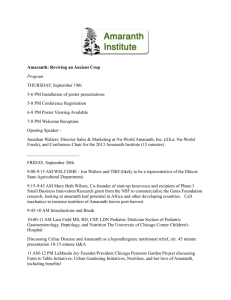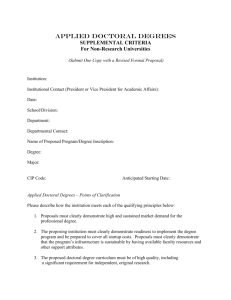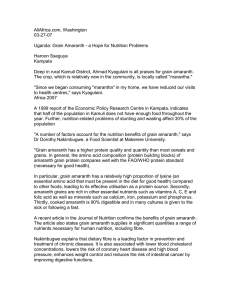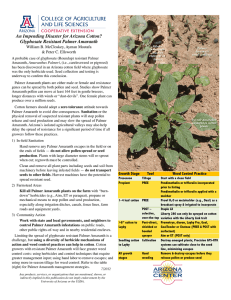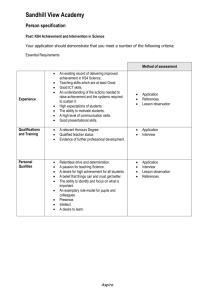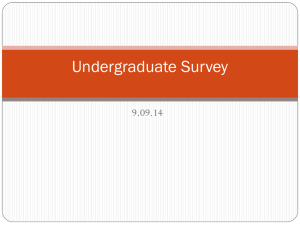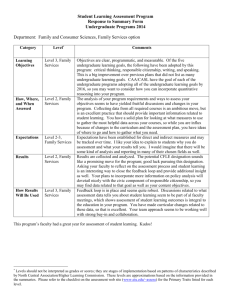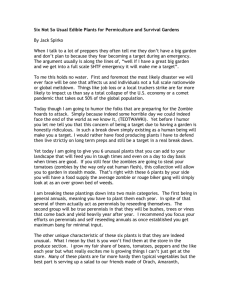Personal Statement - College of Engineering
advertisement
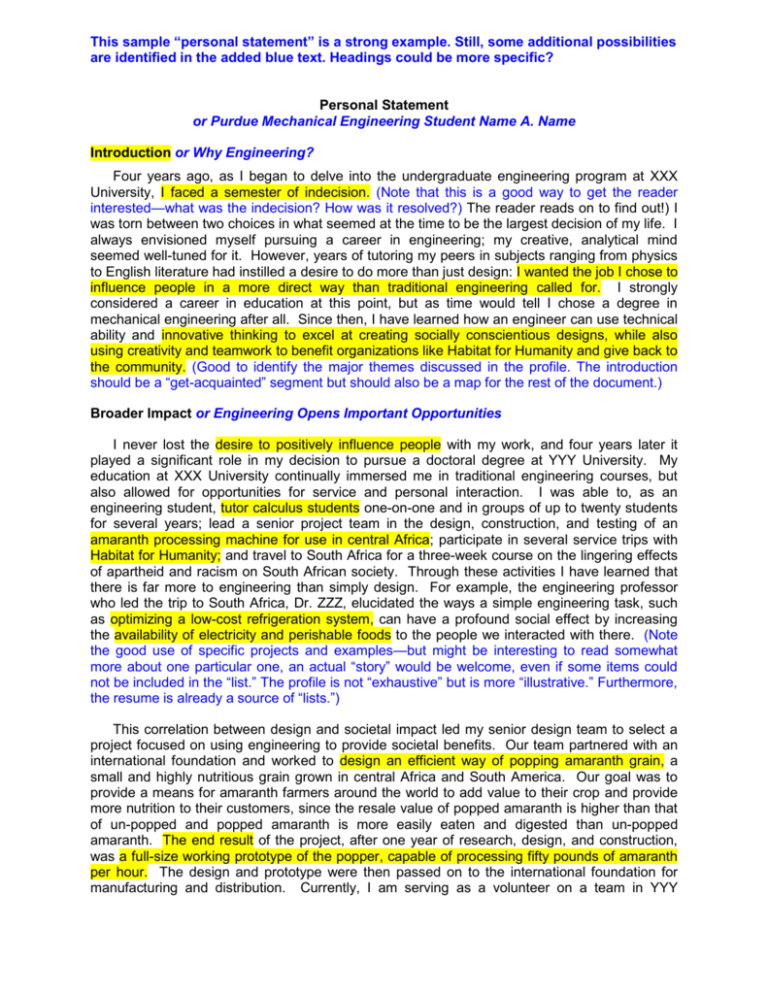
This sample “personal statement” is a strong example. Still, some additional possibilities are identified in the added blue text. Headings could be more specific? Personal Statement or Purdue Mechanical Engineering Student Name A. Name Introduction or Why Engineering? Four years ago, as I began to delve into the undergraduate engineering program at XXX University, I faced a semester of indecision. (Note that this is a good way to get the reader interested—what was the indecision? How was it resolved?) The reader reads on to find out!) I was torn between two choices in what seemed at the time to be the largest decision of my life. I always envisioned myself pursuing a career in engineering; my creative, analytical mind seemed well-tuned for it. However, years of tutoring my peers in subjects ranging from physics to English literature had instilled a desire to do more than just design: I wanted the job I chose to influence people in a more direct way than traditional engineering called for. I strongly considered a career in education at this point, but as time would tell I chose a degree in mechanical engineering after all. Since then, I have learned how an engineer can use technical ability and innovative thinking to excel at creating socially conscientious designs, while also using creativity and teamwork to benefit organizations like Habitat for Humanity and give back to the community. (Good to identify the major themes discussed in the profile. The introduction should be a “get-acquainted” segment but should also be a map for the rest of the document.) Broader Impact or Engineering Opens Important Opportunities I never lost the desire to positively influence people with my work, and four years later it played a significant role in my decision to pursue a doctoral degree at YYY University. My education at XXX University continually immersed me in traditional engineering courses, but also allowed for opportunities for service and personal interaction. I was able to, as an engineering student, tutor calculus students one-on-one and in groups of up to twenty students for several years; lead a senior project team in the design, construction, and testing of an amaranth processing machine for use in central Africa; participate in several service trips with Habitat for Humanity; and travel to South Africa for a three-week course on the lingering effects of apartheid and racism on South African society. Through these activities I have learned that there is far more to engineering than simply design. For example, the engineering professor who led the trip to South Africa, Dr. ZZZ, elucidated the ways a simple engineering task, such as optimizing a low-cost refrigeration system, can have a profound social effect by increasing the availability of electricity and perishable foods to the people we interacted with there. (Note the good use of specific projects and examples—but might be interesting to read somewhat more about one particular one, an actual “story” would be welcome, even if some items could not be included in the “list.” The profile is not “exhaustive” but is more “illustrative.” Furthermore, the resume is already a source of “lists.”) This correlation between design and societal impact led my senior design team to select a project focused on using engineering to provide societal benefits. Our team partnered with an international foundation and worked to design an efficient way of popping amaranth grain, a small and highly nutritious grain grown in central Africa and South America. Our goal was to provide a means for amaranth farmers around the world to add value to their crop and provide more nutrition to their customers, since the resale value of popped amaranth is higher than that of un-popped and popped amaranth is more easily eaten and digested than un-popped amaranth. The end result of the project, after one year of research, design, and construction, was a full-size working prototype of the popper, capable of processing fifty pounds of amaranth per hour. The design and prototype were then passed on to the international foundation for manufacturing and distribution. Currently, I am serving as a volunteer on a team in YYY University Small Business Alliance helping the foundation prepare the design for use in Uganda, where it will provide valuable nutrition to residents of several hospitals and orphanages. (This is compelling—and close to a real story! Still wondering—what were the engineering challenges of the machine—and, even, how did it work?) As mentioned, my desire to produce meaningful changes through my work played a significant role in my decision to pursue a doctoral degree at YYY University. My long-standing desire to work in alternative energy is one way I am planning on merging my engineering degree with my desire to affect change in the way things are done. I thrive on challenges and intend to work on the cutting edge, researching and solving problems that have never been solved. This desire meshes well with society’s growing need for diverse, clean energy sources. My goal, therefore, in pursuing a doctoral degree, is to use my engineering aptitude to work towards discovering ways of improving energy usage. This problem, as my trip to South Africa taught me, is certainly an international problem. There is a finite amount of energy available to the world, and as an engineer I have the opportunity to develop new and innovative ways of distributing that energy efficiently and equitably across borders and demographics, ensuring equal technological access for citizens of all countries. (This is all true, but it is also very general? Specifics would add depth and credibility—e.g., references to specific concerns such as warming trends, fossil fuel and air quality, etc.) Intellectual Merit My passion for, and interest in, energy generation has shaped both my choice of undergraduate studies and the internships I have held. At XXX University I enjoyed and excelled in mechanical engineering courses ranging from control systems to thermal system design. These courses gave me a technical understanding of energy production and usage, which has focused my interest in renewable energy generation technologies, such as wind and hydrogen power. One example of this is the semester-long project for my thermal systems design course, which involved the specification of a demonstration wind turbine, now installed and operational on campus. In addition to specifying the turbine, we worked through significant campus politics to ensure its acceptance by the college community and leaders. I have also chosen my internships over the past four summers based on my interest in energy generation and its impact on the environment. My work at MMM Engineering centered on salmon loss mitigation through Columbia River hydroelectric facilities, and my time at NNN Energy Company showed me how high cost and negative public opinion about alternative generation technologies like wind and nuclear power have prevented industry change and forced the continued use of older fossil fuel technologies. (Something that happened vis-a-vis “public opinion” might be very interesting!) The summer undergraduate research program that I participated in at YYY University acted as my formal transition into a graduate research environment. As an undergraduate researcher, I was able to work alongside graduate students and professors to develop novel methods of storing hydrogen using enhanced metal hydrides. The summer program also served as a thorough introduction to many of the technical aspects of the research I am currently working on in metal hydrides, as well as the facilities at the YYY University Hydrogen Energy Center. (This paragraph really just identifies a credential—it would be great to learn about something that happened in this new environment that made a difference, e.g., contributed to the student’s decision to pursue more such experiences. Otherwise, the work can be condensed to an outcome, mentioned in a list, and the saved space used elsewhere to greater effect?) Conclusion or Impacting our Energy Future One thing my internships and studies have taught me about myself is that I thrive on challenges. The tasks which I most enjoy are the ones which are new, difficult, and thoughtprovoking. This is what initially convinced me that graduate research was an option well suited to my abilities and desires. Research at technology’s leading edge offers countless challenges and opportunities to be involved in technological advancements. I am seeking a research career on the cutting edge of energy generation technology so that I can be continually challenged and make an impact on the way energy is used in our world. (Here is good connection with themes introduced early—that is, desire to use engineering to help people. Still, it would be interesting to learn what might the result look like—reaching for visualization would be welcome. Would it be possible to reach for more specific goals?) Stats: Words: 1,100 Font: Arial Headings 4 Pages 2

